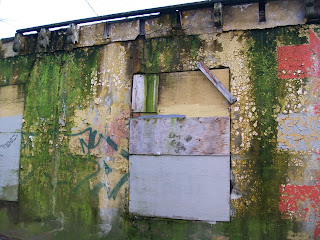Constructed in 1931 by the Shell Oil Company it originally opened as the Lion's Gate Super Service Station. At that time Shell B.C. had only been incorporated for two years and had a grand total of 19 service stations.
Another historical fact connected to this service station is its original owner, Thomas Chang. He was the son of Chinatown importer-exporter Chang Toy (Sam Kee). Remember the narrowest building in the world? That Chang Toy.
Thomas was a leader in several Chinatown benevolent societies and apparently a pretty good businessman. Even though the economy was poor, Chang installed a fifth service bay in 1933. Lion's Gate Super Service Station operated for over two decades and it was still owned by Shell two years after Chang's death.
In 1955 it became Henry’s Service Station and was operated by H.H. Leong. After the service closed in the 1970's it served as a storage facility for Max Goldberg Supply Ltd., a well-patronized dealer in plumbing supplies located adjacent at 424 Main Street. Remember that there was once a strong Jewish community in this area as well.
We are still on East Pender in Chinatown. This is 111. It was erected in 1903 by Victoria based Chu Lai. Like others in his position, Chu accumulated his wealth during the Cariboo Gold Rush. Chu was also very involved in the community - promoting education, helping to establish social connections and fighting, often successfully, discriminatory legislation.
As was common with a lot of buildings in Chinatown, the lower floors were used for trading companies and the upper for residential and club rooms. The rear of 111 East Pender also has a history of its own. There is a door there that faces the alley, once known as Market Alley, and in the 1930s a restaurant known as the Green Door opened to the public and the gambling club on that side of Pender Street. The illusion of the `secret` hideaway appealed to poets, academics and revolutionaries in the 1960s and 1970s when they adopted the place as a hangout. (The pictures I saw at HistoricPlaces.ca show this building as being painted green)
 This is not the door in question. Going into an alley in this part of town with a camera could prove hazardous to my health so I don`t do it!
This is not the door in question. Going into an alley in this part of town with a camera could prove hazardous to my health so I don`t do it!This tree is more than just a Snake Bark Maple tree. It was planted on April 4, 2008 by the Vancouver Art Gallery, Vancouver Board of Parks and Recreation in collaboration with the citizens of Strathcona.
Mexican artist Pedro Reyes began a project called Palas por Pistolas in 2007. Reyes traded food vouchers for firearms which were melted down and remade into shovels. These shovels were used to plant trees - 1,527 firearms became 1,527 shovels. This was the first tree planted as an international project.
When I first started to post these two pictures and do research I almost wrote on the wrong place. There is an Arno Hotel on East Cordova as well or at least a building that used to be known as that. This is located at 291 East Georgia and I am showing you 293 as well.
This building was designed in 1911 by architects Edward Evans Blackmore and Samuel Buttrey Birds and constructed for Leon Way and Company. Blackmore and Birds were not formally partners but the two teamed together often and were responsible for much of Vancouver`s development.
The building is a relatively simple commercial/residential block but it does have some interesting features such as the bay windows on the corner at Gore and East Georgia, the fire escape and the cornice.
This is another example of a building with retail services on the lower level and residential on the upper floors. It was done during this period because of the large amount of single Chinese males - discriminatory legislation of the time made it difficult and later impossible for men to bring over their wives and children. However we still see it today and for those living in apartments it is convenient, often desired, to have retail on the ground floor.
I hope you find the beauty around you.
TAGS:Vancouver, Karen Magill, Shell Oil Station, Lions Gate Super Service Station,Thomas Chang,Max Goldberg Supply Limited,History,W.T. Whiteway,Blackmore and Birds




















Hi Karen! I haven't talked to you in a month of Sundays...how are you doing??? Beautiful pics! Vancouver has such great architecture!
ReplyDelete